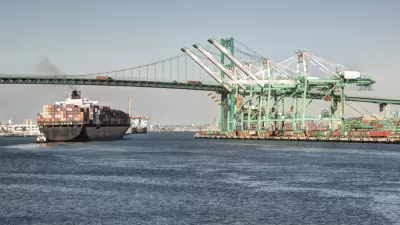Differences between the clean trucks programs at the ports of Long Beach and L.A. may bring months of litigation, derailing clean air efforts at the nation's largest port complex.
The article contains an interview with Patty Senecal, who oversees California Governmental affairs for the International Warehouse Logistics Association (IWLA).
"Of the 800,000 for-hire trucks in the national trucking market, 400,000 are owner-operator contractor drivers. There is no legal authority for the Port of L.A. to impose an employee mandate on interstate commerce, thus costly litigation is likely to be triggered and capital improvements and clean air will be delayed."
"The structure of the steamship lines over the past ten years has changed. Consolidation and slot chartering among the steamship lines is now common. Containers' loads and empties are moving between both ports. It will create an operational nightmare to have restrictions on where trucks can and can't operate based on who is driving the truck. This will reduce the efficiency for cargo movement for terminal operators and truckers. This inefficiency will needlessly increase cost and pollution and reduce through-put of cargo."
"California goods movement logistics and transportation providers are learning that it is not just about diesel particulates anymore-environmental regulations are implementing the deal with climate changes and reducing the carbon footprint of goods movement. Our first response is to communicate with our importers and exporters that new regulations are in place from the state/ports and that freight transportation will cost more in the near future. As a baseline, we have to prepare for the CARB rules that take effect January 1, 2010."
FULL STORY: A Private Sector Critique of Recently Adopted Port Clean Truck Plans: IWLA’s Patty Senecal

Alabama: Trump Terminates Settlements for Black Communities Harmed By Raw Sewage
Trump deemed the landmark civil rights agreement “illegal DEI and environmental justice policy.”

Study: Maui’s Plan to Convert Vacation Rentals to Long-Term Housing Could Cause Nearly $1 Billion Economic Loss
The plan would reduce visitor accommodation by 25% resulting in 1,900 jobs lost.

Why Should We Subsidize Public Transportation?
Many public transit agencies face financial stress due to rising costs, declining fare revenue, and declining subsidies. Transit advocates must provide a strong business case for increasing public transit funding.

Paris Bike Boom Leads to Steep Drop in Air Pollution
The French city’s air quality has improved dramatically in the past 20 years, coinciding with a growth in cycling.

Why Housing Costs More to Build in California Than in Texas
Hard costs like labor and materials combined with ‘soft’ costs such as permitting make building in the San Francisco Bay Area almost three times as costly as in Texas cities.

San Diego County Sees a Rise in Urban Coyotes
San Diego County experiences a rise in urban coyotes, as sightings become prevalent throughout its urban neighbourhoods and surrounding areas.
Urban Design for Planners 1: Software Tools
This six-course series explores essential urban design concepts using open source software and equips planners with the tools they need to participate fully in the urban design process.
Planning for Universal Design
Learn the tools for implementing Universal Design in planning regulations.
Smith Gee Studio
Alamo Area Metropolitan Planning Organization
City of Santa Clarita
Institute for Housing and Urban Development Studies (IHS)
City of Grandview
Harvard GSD Executive Education
Toledo-Lucas County Plan Commissions
Salt Lake City
NYU Wagner Graduate School of Public Service



























